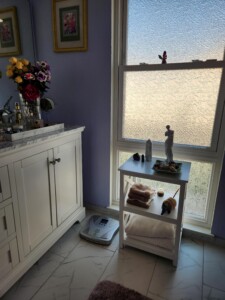
In Master Gahle Atherton’s book, Feng Shui:The Perfect Arrangement, she gives exhaustive examples of how Qi flows through both exterior and interior spaces, including the Qi (air currents) in relation to doors and windows. This is not special, in and of itself, as many authors will note the standard good and bad alignments between windows and doors.
However, Atherton takes it much further, to even explain the influences between more than one window, as well as the height of a window or its position from the floor. Stay tuned for a full review of her book, coming soon.
Based on how Qi is often described, it’s easy to just imagine the Qi shooting from the door and through a window like a bullet in the middle range of the room’s height. We even have three sections to categorize a room: upper level, middle level and lower level. Sometimes these divisions are referred to as Heaven, Man, and Earth. This is a nod to another principle of Heaven Luck, Man Luck and Earth Luck. Briefly, there are three major ways in which we experience life, including pre-birth contracts, decisions we make post-birth, and the influences coming from outside ourselves in the environment. As described by Heluo Hill, we can also modernize the reference to Heliocentric, Egocentric and Geocentric designations.
Back to doors and windows: The qi entering a room does not just travel in a straight line. Qi can travel along walls, floors, and ceilings like spilled syrup. The interior design and architectural features of any room will manipulate the Qi flow, the speed and momentum.
If a window is floor-to-ceiling, this is a circumstance where the Qi can leak out of the room easier than other arrangements. If the Qi leaks out of the room too soon, it cannot supply the occupants with enough life force energy. Think about how humans used to live so much more outdoors, with all the benefits of fresh air and sunshine. However, in modern times we are indoors more than not. It becomes that more vital to make sure our interior spaces support our health, can breathe, but not lose the Qi too soon.
In the scheme of things, a solid wall is, by definition, the hardest blockade for Qi to escape through. We can discuss how Qi can move through walls, but that is another article topic. The solid wall contains the Qi better than a window. A window that does not open is more effective in holding the Qi than a window that opens. This is easy to fathom.
When a window reaches the floor or the top of the ceiling, the Qi can easily escape. This is where interior adjustments can be made with furnishings and certainly with window coverings.
It is not common to see a window so low that it is near the floor, especially when the top part is not right at the ceiling. Just looking at that would look odd and asymmetrical. Atherton asserts in her book that the “lip” or border of the window needs to be at least 9 inches high from the floor in order for it to not be a problem. This article shows an example of just that kind of window.

Another example is a window which is only a few inches from the floor, but the window has an opaque design. This is another solution to help make the window more “solid” and able to hold onto the Qi. Just short of a structural remediation, there are some simpler solutions which can also involve placing a piece of furniture or live plant in front of the low window to help buffer the Qi flow, so the occupants can have better health and more energy.
Author: Kartar Diamond
Company: Feng Shui Solutions ®
From the Architecture and Design Blog Series

Leave A Comment
You must be logged in to post a comment.